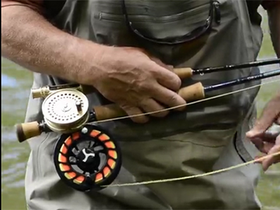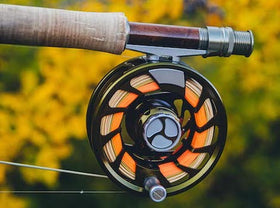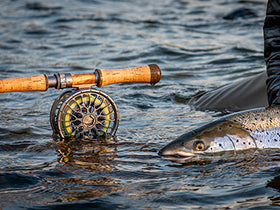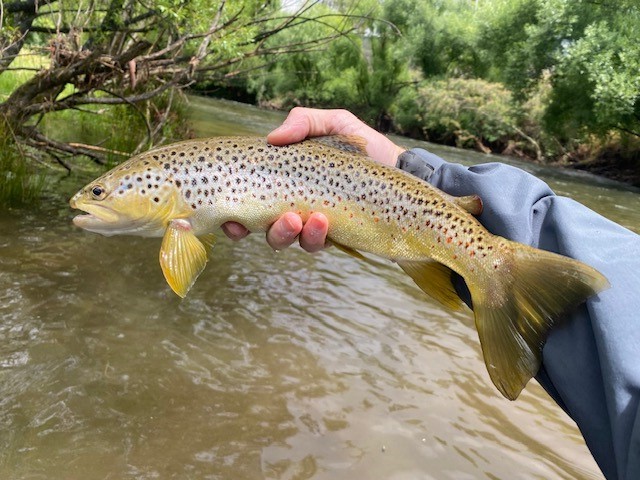
Springtime in rural Victoria creates jobs faster than one can cross off the 'to-do' list. Take one thing off, add two new things on. I had been so busy, the only thing I managed to do in preparation for a day fishing the Kiewa River, was to tie one Squirrel Nymph. One! Luckily, I had plenty of alternatives, but somehow, fishing with a fresh fly gives as much confidence as cooking with fresh ingredients.
The weather last weekend was fascinating. Clouds were building high over the tops of the Bogong High Plains. As I drove into my first spot for the day and parked the car, it started raining heavily. And was that thunder I could hear in the next valley? As I had left my less conductive bamboo rod at home for a dry fly day next month, I would have to resort to side-arm casting with my graphite wand. (Of course, that’s a little fishing joke – I would never do that! Working in risk management means keeping things safe!)
Channeling the adage that there is no bad weather, only bad gear, I happily rigged up my trusty Czech nymph selection of Squirrel Nymph on the point, and the Gasolina Perdigón on the dropper. Probably a never-fail combo anywhere in the world.
Although the BOM gauge online at Kiewa read 1.40m, the flow was surprisingly fast. So, I selected that lovely slow-paced water along the edge, and started operations. The rain was bucketing down by now, which made managing the drift difficult. Not seeing exactly where the flies land (due to all the rain drops) and a tricky half-light causing glare, I was fishing the nymphs mostly on feel. But the first brown of 2lb+ did not need much finesse as it slammed the Squirrel hard, and after a nice careful tussle (yes, still fishing 6X when I shouldn’t!) I got him in the net.

An hour later, it was as if La Niña had passed, and El Niño arrived back. The sun broke through the clouds, and it instantly became steaming hot. Mayfly started to emerge, and I was ready to change. But the trout stayed down, and they kept eating the deep nymphs. I guess the hatch was too sporadic for the fish to show much interest in the surface. I switched reels to a floating line and fished a dry/ dropper through a long run, but alas, not one take. I doubled back and fished the same stretch with Czech nymph style. Half a dozen casts later, along the same seam, I picked up a nice 2.5lb brown. It pays to vary your approach. It pays even more to Czech nymph!

Then I moved up a section and bumped into a lure fisher. He had been fishing a run about 20 metres long which just looked mint. I called out the old “Any luck?” He replied, “Not really.”
As thunder was now starting to roll into the Kiewa Valley, there was little time to move elsewhere. So I asked if he would mind if I tried the section downstream of where he had already fished. “Sure.” came the answer. Second cast in, a thumping 2.5lb brown ate the Squirrel and put up a powerful fight. The spinner was first impressed, and then he quietly left the bank.

Three casts later, I was hooked up again! But this time, my fly had caught another fishing line. As I pulled it in, I gathered about 4 metres of thick mono, and a gleaming spinner trailing behind. Maybe that’s why he left?
I pocketed the line and spinner. The three large, barbed hooks looked ominous against the size 16 barbless Squirrel Nymph. As the whole spinner system was discarded in the river, it could have done some serious damage to people who swim in that pool regularly, or to any fish or wildlife. I am not sure how effective three barbed hooks are anyway, as one barbless fly seemed quite adequate for me!
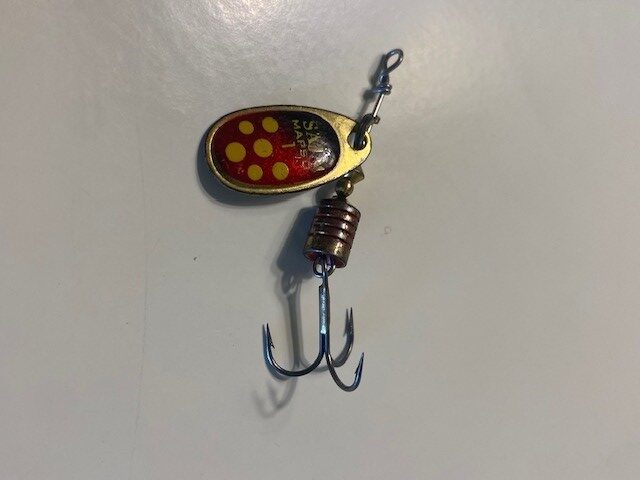 Two hooks too many?
Two hooks too many?As I walked back to the car with hail the size of peas now pummelling me, I wondered if there could be a market for spinners with just one hook, or perhaps even with barbless hooks? Those three hooks on mostly small trout just seem like taking a bazooka to a fist-fight. And by the way, if you read this and you think this spinner is yours, I’ll happily return it to you… but minus 2 hooks.





